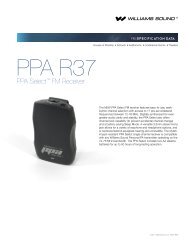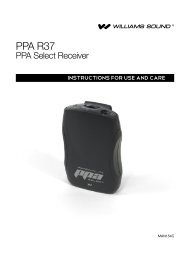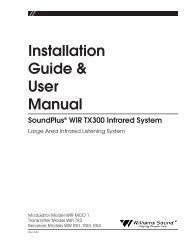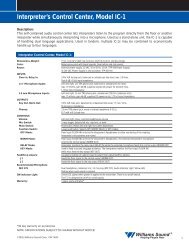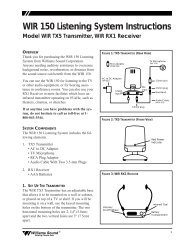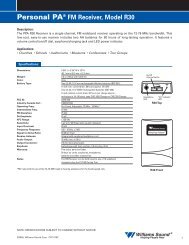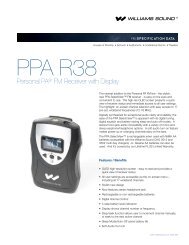Install Instructions - Williams Sound
Install Instructions - Williams Sound
Install Instructions - Williams Sound
Create successful ePaper yourself
Turn your PDF publications into a flip-book with our unique Google optimized e-Paper software.
ASSURING EXCELLENT PERFORMANCEThe PPA 250 consists of a transmitter and several receivers used to deliver an audio signal tolisteners who are hard of hearing. The audio signal is usually provided by equipmentmanufactured and installed by others. The PPA 250 provides excellent audio performanceunder most conditions. However, <strong>Williams</strong> <strong>Sound</strong> equipment does not correct faults inincoming audio. This section is intended to help installers and users recognize properoperation and correct faults whenever possible.The following tests can be done without instruments to assure that a system is workingproperly.HOW TO RECOGNIZE PROPER OPERATIONStep 1: Play a compact disc through the complete sound system at a level that is typical ofnormal operation.Listen to the hearing assistance system using a receiver with a factory-suppliedearphone. Set the volume on the receiver at about 3. Comfortable listening isusually achieved with a setting of 2, or even lower. If you have normal hearing, avolume control setting of 3 will likely be too loud for comfortable listening. Thereshould be no audible distortion, hum or noise.<strong>Williams</strong> <strong>Sound</strong> wide band FM systems transmit audio using the same technicalstandards as FM Broadcast radio. Therefore, the received sound should be of highquality. Using a suitable adapter (Radio Shack Part #274-361), you can connect aprofessional headphone to a receiver for a critical evaluation.Step 2: Pause or stop the CD.There should be no significant increase in noise or hum immediately after thesound is stopped.Step 3: Play the CD again.Listen to the system using a receiver. Check for coverage in the listening area.Walk through and around the entire audience area. The sound in the receivershould remain clear and noise–free within the audience area.Some small spots in the listening area will seem to “dropout”, getting no signal.This is normal and is caused by RF signal reflections from relatively largeelectrically conductive objects. In most installations, the areas of reduced receptionare less than one foot wide and few in number. Moving the receiver only a fewinches usually restores reception.<strong>Williams</strong> <strong>Sound</strong> ®Helping People Hear17



